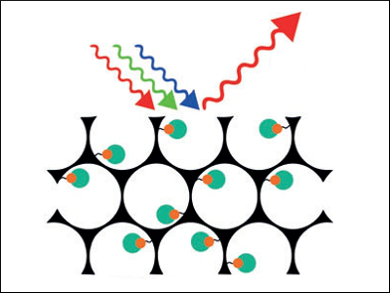Bioassays based on inverse opal hydrogels (IOHs) can be used to detect hydrophobic analytes as they swell or shrink upon analyte binding, resulting in a color change.
André Lashewsky, University of Potsdam, Germany, Erik Wischerhoff, Fraunhofer Institut für Angewandte Polymerforschung, Potsdam, and colleagues noted that there is a lack of IOH systems for sensing large analytes such as macromolecules, viruses, or bacteria. The team designed a dual-responsive (i.e., temperature-dependent and analyte-binding) IOH that possesses large channels so that the analyte can easily diffuse throughout the system. The hydrogel undergoes a volume phase transition that results in significant spectral changes upon analyte binding.
The researchers developed IOHs based on copolymers of oligo(ethylene glycol) mixtures. These biocompatible materials allow an induced collapse-to-coil phase transition when analyte binding shifts the phase transition temperature from below to above the sensing temperature. They assembled monodisperse silica nanoparticles to form synthetic opal, a precursor monomer mixture was added, photopolymerized to form a filled hydrogel, and the template nanoparticles were removed with HF. These thermoresponsive IOHs shrink upon heating, resulting in a shift of the Bragg peak position by 130–200 nm and color changes. When the comonomers are functionalized with recognition groups such as mannose or biotin, hydrophobic analytes such as lectin and avidin can be detected.
The scientists anticipate that their approach can be applied to a new type of low-cost biosensors.
- Responsive Inverse Opal Hydrogels for the Sensing of Macromolecules,
Jean-Philippe Couturier, Martin Sütterlin, André Laschewsky, Cornelia Hettrich, Erik Wischerhoff,
Angew. Chem. Int. Ed. 2015.
DOI: 10.1002/anie.201500674



